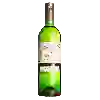
Château du PrioratBergerac Sec
This wine generally goes well with
Details and technical informations about Château du Priorat's Bergerac Sec.
Discover the grape variety: Crescent
A direct-producer hybrid of American origin resulting from an interspecific cross between Saint Pepin and Elmer Swenson 6-8-25 (vitis riparia X Hamburg muscatel) obtained in 1988 by Peter Hemstad and James Luby at the University of Minnesota Research Center (United States). It can also be found in Canada, Ukraine, Russia, etc. and is virtually unknown in France.
Informations about the Château du Priorat
The Château du Priorat is one of of the world's greatest estates. It offers 4 wines for sale in the of Bergerac Sec to come and discover on site or to buy online.
The wine region of Bergerac Sec
The wine region of Bergerac Sec is located in the region of Bergerac of South West of France. Wineries and vineyards like the Château Tour des Gendres or the Château Barouillet produce mainly wines white, red and sweet. The most planted grape varieties in the region of Bergerac Sec are Muscadelle, Cabernet-Sauvignon and Merlot, they are then used in wines in blends or as a single variety. On the nose of Bergerac Sec often reveals types of flavors of citrus, pear or oil and sometimes also flavors of non oak, floral or cheese.
The wine region of South West
The South-West is a large territorial area of France, comprising the administrative regions of Aquitaine, Limousin and Midi-Pyrénées. However, as far as the French wine area is concerned, the South-West region is a little less clear-cut, as it excludes Bordeaux - a wine region so productive that it is de facto an area in its own right. The wines of the South West have a Long and eventful history. The local rivers play a key role, as they were the main trade routes to bring wines from traditional regions such as Cahors, Bergerac, Buzet and Gaillac to their markets.
The word of the wine: Phylloxera
Aphid that came from America and ravaged European vineyards at the end of the 19th century. It lives on the roots of the vine, from which it pumps the sap. The only vines capable of resisting it had to be imported from the United States, and then grafted onto their root system the wood of traditional French grape varieties. Today, grafted vines are always planted.












